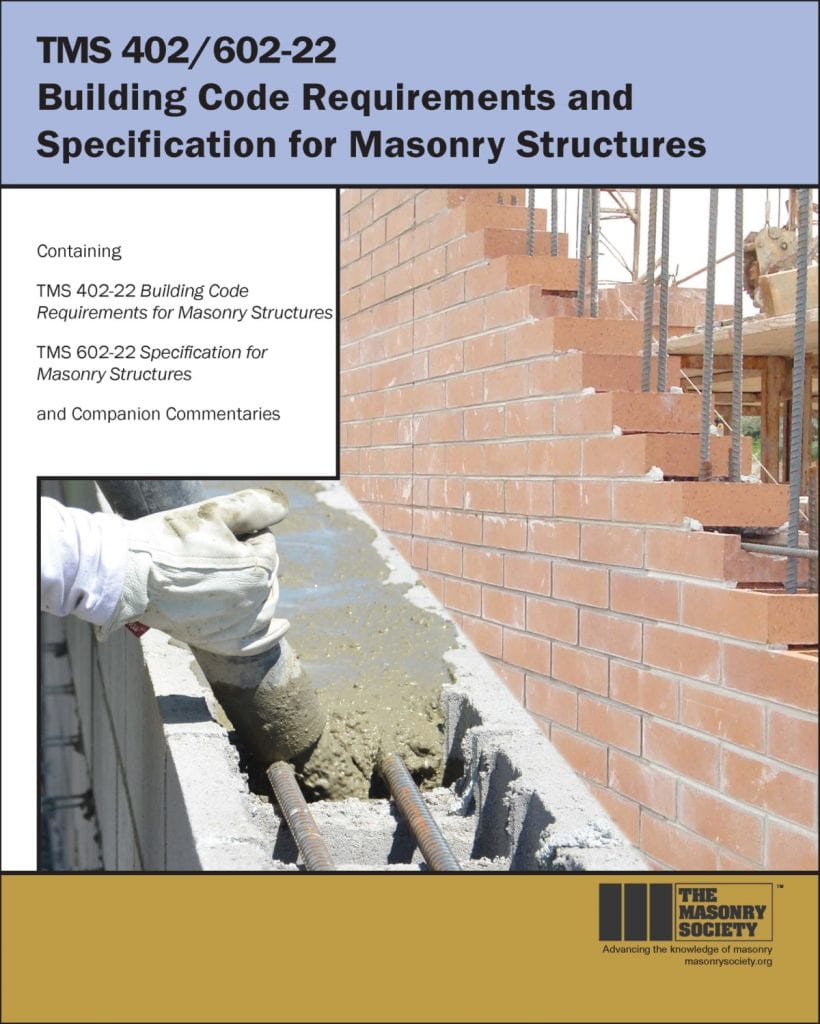The New TMS 402/602-22
Review of the New Standards and Changes Made
Masonry experts and Committee leaders review the new standards TMS 402-22 Building Code Requirements for Masonry Structures and TMS 602 Specification for Masonry Structures and changes made since the 2016 edition. These standards will form the basis for masonry design provisions in the 2024 International Building Code and other model building codes and include some major new provisions that include a new appendix on masonry partition walls reinforced with Glass Fiber Reinforced Polymer (GFRP) reinforcement, completely revised anchored and adhered veneer provisions, and enhancements throughout the standards.
Viewers are encouraged to have a copy of TMS 402/602-22 Building Code Requirements and Specification for Masonry Structures.

or purchase sessions individually at the links below
| Session 1 – Overview of Changes in TMS 402/602-22 and Review of the Specification for Masonry Structures Presented by John Chrysler, PE, FTMS TMS 402/602-22 Committee Chair |
| Session 2 – Major Structural Design Changes in TMS 402/602-22 Presented by Richard Bennett, PhD, PE, FTMS, University of Tennessee, Knoxville TMS 402/602-16 Committee Chair, Design Subcommittee Member |
| Session 3 – Seismic/Limit States Design per TMS 402/602-22 Presented by John Hochwalt, PE, SE, FTMS, KPFF Consulting Engineers Seismic/Limit Design Subcommittee Chair |
| Session 4 – Masonry Veneer Requirement Changes in TMS 402/602-22, A Whole New Chapter Presented by Brian Trimble, PE, CDT, LEED AP, FASTM, IMI Veneer & Glass Block Subcommittee Chair |
| Session 5 – Using the New Appendix D on Composite Reinforcement in Masonry Presented by Heather Sustersic, P.E., Colby Company Engineering Reinforcement & Connectors Subcommittee Chair |
| Continuing Education Credit: 1 PDH / 0.10 CEU / 1 AIA LU per session |
Course Descriptions
Session 1 – Overview of Changes in TMS 402/602-22 and Review of the Specification for Masonry Structures
This course reviews the major changes from the 2016 edition to the 2022 edition of TMS 402/602. The 2022 edition was created using the first six-year revision cycle, allowing more comprehensive consideration of significant changes and reorganization of these Masonry Standards. In addition to reviewing the changes to the standards, this presentation reviews the Specification for Masonry Structures (TMS 602) and discusses the importance of why designers should be aware of how masonry is constructed.
Session 2 – Major Structural Design Changes in TMS 402/602-22
This session provides an overview of the major structural changes in TMS 402-22. One of the biggest changes was the introduction of compression-controlled sections in strength design. As a result of this, the maximum reinforcement provisions were deleted except for beams and intermediate and special shear walls under in-plane loads. The basis for the provisions, the impact on design, and some design aids is presented.
Other structural changes that are covered include: definition of net shear area particularly for beams, anchor bolt steel strength changing from being based on yield strength to ultimate strength, an increase of the allowable compressive force for masonry in allowable stress design, a change in the partially grouted shear wall factor, and an increase in the allowable shear friction strength as well as a change in the nominal shear friction strength for shear span ratios greater than 1. The potential impacts of these changes will also be reviewed.
Session 3 – Seismic/Limit States Design per TMS 402/602-22
This session of the TMS 402/602-22 Night School will review the changes to the provisions in Chapter 7 and Appendix C that effect the seismic design of masonry structures. This will include revisions to the requirements for special reinforced masonry shear walls, changes to the requirements based on the assigned Seismic Design Category, and changes made to the treatment of seismic displacements in the masonry code, including a new deformation compatibility provision. The potential impacts of these changes will also be reviewed.
Session 4 – Masonry Veneer Requirement Changes in TMS 402/602-22, A Whole New Chapter
The chapter on masonry veneer has been extensively revised and updated for the 2022 edition of TMS 402/602. Prescriptive requirements for both anchored and adhered veneer have been simplified with many of the major requirements now found in a one or two tables. A tributary area method was added for engineered design of anchored veneer as well as guidance for modeling anchored veneer in a full engineered design. Both the prescriptive and engineered provisions for adhered veneer were enhanced. Learn how to design masonry veneer with the new provisions and determine where your specifications need to be upgraded to meet the new requirements. Also learn about updated installation and inspection requirements and allowable tolerances for both types of veneer in construction. The updated requirements will simplify the design of your masonry veneer projects and assure the most efficient design methods are being used.
Session 5 – Using the New Appendix D on Composite Reinforcement in Masonry
Glass Fiber Reinforced Polymer (GFRP) reinforcement in concrete was first introduced over 25 years ago by way of ACI 440R, but prior to TMS 402/602 2022, no companion guidelines existed for masonry construction. The new Appendix D of TMS 402/602 is a first standard in the U.S. for the use of GFRP reinforcement in masonry. GFRP reinforcement has applications in masonry for specialty use near electromagnetic equipment and in locations exposed to severe environments. Learn how to use the new Appendix D to design and specify GFRP reinforced masonry for your next project.
